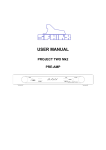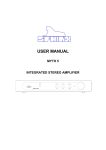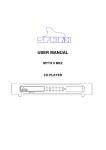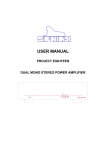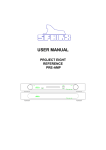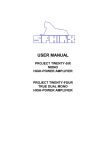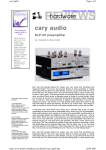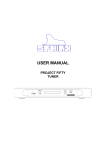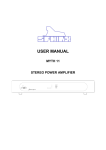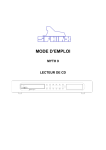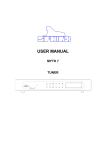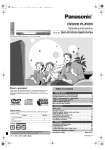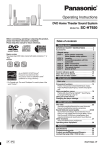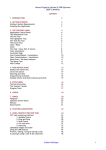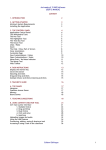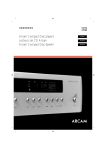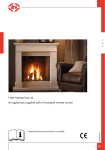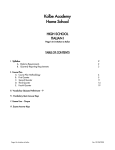Download USER MANUAL
Transcript
USER MANUAL PROJECT THIRTY-TWO CD PLAYER SPHINX Project 32 1. UNPACKING .......................................................................................................................................3 2. SPHINX WARRANTY CARD ..............................................................................................................3 3. THE CD PLAYER AT A GLANCE.......................................................................................................4 Front panel................................................................................................................................................... 4 Rear panel ................................................................................................................................................... 5 Display ......................................................................................................................................................... 6 4. INSTALLATION AND CONNECTIONS ..............................................................................................7 Installation.................................................................................................................................................... 7 Connecting the mains cable ........................................................................................................................ 7 Connections................................................................................................................................................. 7 Audio connections ....................................................................................................................................... 7 Balanced.................................................................................................................................................... 7 Unbalanced ............................................................................................................................................... 7 Digital connections....................................................................................................................................... 7 Optical ....................................................................................................................................................... 7 Coax .......................................................................................................................................................... 7 Sphinx Control optical cables....................................................................................................................... 7 5. OPERATION........................................................................................................................................8 Power on...................................................................................................................................................... 8 Playing a CD ................................................................................................................................................ 8 Playing a different track ............................................................................................................................... 8 Fast search in a track .................................................................................................................................. 8 To temporarily halt Play (PAUSE)................................................................................................................ 8 To stop Play (STOP) .................................................................................................................................... 8 Power off...................................................................................................................................................... 8 6. THE SPECIAL MODES .......................................................................................................................9 Display brightness ....................................................................................................................................... 9 Polarity ......................................................................................................................................................... 9 Input selection for the D/A converter............................................................................................................ 9 Sphinx Control ........................................................................................................................................... 10 Repeat ....................................................................................................................................................... 10 Output Level............................................................................................................................................... 10 SPHINX REMOTE CONTROL ..............................................................................................................11 Buttons....................................................................................................................................................... 11 Operation ................................................................................................................................................... 12 Selecting without switching ........................................................................................................................ 12 Batteries..................................................................................................................................................... 12 Encountering problems.............................................................................................................................. 12 CARE AND MAINTENANCE.................................................................................................................13 The best way to treat a CD ........................................................................................................................ 13 Removing it from the box ........................................................................................................................... 13 Cleaning..................................................................................................................................................... 13 Storing ....................................................................................................................................................... 13 TECHNICAL SPECIFICATIONS ...........................................................................................................14 2 SPHINX Congratulations on your purchase of the Sphinx Project Thirty-two! You are now part of an ever-increasing group of quality-conscious audiophiles using Sphinx products. We are very proud of the tradition connected with the SPHINX name, especially concerning audio quality perfection. This manual will help you to gain a maximum amount of pleasure and quality from your new Sphinx Project Thirty-two HDCD player. This remarkable HDCD player is based upon the latest Philips CDM-12.4 mechanism. One of the special features is the discrete Class A output amp section. The three separate ‘R-core’ transformers for the digital and analogue sections plus the integrated power supply filter ensure an extremely high S/N-ratio. A really unique feature are the 24 bit 8-times oversampling D/A-converters of which there are two in each channel: meaning the True Balanced signal path is actually starting in the digital domain! Project 32 1. UNPACKING Before leaving the factory every Project Thirty-two is subjected to stringent and extensive technical and exterior quality inspection. This ensures you will enjoy many years of high quality audio performance from a perfect-looking product. After unpacking your Project Thirty-two we therefore recommend you carefully check it for any transport damage. In case of damage: please contact your Sphinx dealer immediately and retain all packing materials for possible proof of damage and possible claims. Even if the component is in perfect condition you should still keep the packing materials. If you need to transport your Project Thirty-two at a later time it will be best protected by the original packing materials. 2. SPHINX WARRANTY CARD Extremely handy are the extra digital inputs by means of which the D/A-converters are also separately available for external signals. The Project Thirty-two thus offers two distinct functions from just a single component. Please take this opportunity to fill out the enclosed warranty card now! Follow the instructions on the card or consult your dealer. Please send the card as soon as possible to the return address (within 14 days after purchase). Almost all functions are accessible with the supplied Sphinx Remote Control. To obtain the maximum quality from this CD player it is necessary to use it with top quality audio components, preferably with other Sphinx components. Please read this manual carefully before you install or use the Project Thirty-two. It is important to familiarise yourself with the special functions, operation and possibilities of the Sphinx Project Thirty-two. Your local dealer will be able to answer any questions concerning other Sphinx audio components. 3 SPHINX Project 32 3. THE CD PLAYER AT A GLANCE Front panel 1. Cabinet with mechanism including all electronic circuits 2. CD tray: To be opened with the OPEN button (4). Place the CD here. Close with the CLOSE (4) or the PLAY button (9). 3. Receptor window for the IR signals from the Remote Control. 4. OPEN/CLOSE/STOP: This button opens the CD tray, closes the CD tray or stops the CD playback. 5. SETUP: Depressing this button for more than 2 sec activates the Set-up mode: the display shows the first parameter to be changed. By pressing this button you can ‘cycle’ through the available parameters. Pressing the STANDBY button (6) de-activates the Set-up mode (for more information see Chapter 6. THE SPECIAL MODES). 8. PREV: To select a lower number track. If you hold the button depressed it will activate a fast reverse search in the current track. 9. PLAY/PAUSE: To start playback of the track indicated in the display. Note: If the CD tray is still open it will close automatically. To temporarily interrupt CD playback. The display will show the “PAUSE” indication. Pressing this button again will resume playback. 10. NEXT: To select a higher number track. If you hold the button depressed it will activate a fast forward search in the current track. * 11. HDCD : This indication will light when a HDCD recording is played 12. Power supply: This separate cabinet contains the complete power supply for the: left channel, right channel and the digital section. 6. STANDBY: To switch the CD player on and off. 7. Display: This will show all important data (more information can be found on page 6). * HDCD® and High Definition Compatible Digital are registered trademarks of Pacific Microsonics Inc. 4 SPHINX Project 32 Rear panel 13 CE: Label showing equipment conforms to official European standards. 23 DC POWER OUT: To connect the flat-cable to the mechanism housing (see 22.). 14 BALANCED OUT R: Connect this to the right (balanced) CD input of the pre-amplifier. BALANCED OUT L: Connect this to the left (balanced) CD input of the pre-amplifier. 24 Sphinx logo 15 OUT R: Connect this to the right CD input of the pre-amplifier. OUT L: Connect this to the left CD input of the pre-amplifier. 16 CONTROL OUT: To connect the optical cable to the next Sphinx component (e.g. tuner). 17 CONTROL IN: To connect the optical cable from the pre-amplifier. 25 Manufacturer's label: This shows important data for the component, such as serial number and mains power voltage. 26 Warning!: This shows important information about the safety regulations for the Project 32. 27 AC Power: Connect the mains cable to a mains power outlet (100 - 240 VAC). The mains fuse is placed behind the cover. Here you also find the mains power switch for the CD player (O/I). 18 OPTICAL OUT: TOSHLINK optical digital output. To connect an external D/A converter or MD/DAT recorder. 19 OPTICAL IN: TOSHLINK optical digital input. To connect a separate CD player, MiniDisc player or other digital replay equipment. 20 COAX OUT: Digital output (75 ohm). To connect an external D/A converter or MD/DAT recorder. 21 COAX IN: Digital input (75 ohm). To connect a separate CD player, MiniDisc player or other digital replay equipment. 22 DC POWER IN: To connect the flat-cable from the power supply (see 23.). 5 SPHINX Project 32 Display The display of the Project Thirty-two shows information depending on the mode selected. In the next section you’ll find the indications of the main modes. A detailed explanation of each you will find in Chapter 5. Operation and Chapter 6 The Special Modes. When the CD player is in Standby mode the display shows: - After you have placed a CD in the tray and pressed the CLOSE button (4) the display shows (sequentially): TRAY CLOSE Pressing the STANDBY button (6) changes the display first to: SPHINX PROJECT 32 READING DISC And then to: TOTAL TRACK 19 70:54 READING DISC NO DISC The other displays will be explained in Chapter 5 and 6. This means there is no CD in the tray. Pressing the OPEN button (4) opens the tray and the display now shows: TRAY OPEN 6 SPHINX Project 32 4. INSTALLATION AND CONNECTIONS Installation The Project Thirty-two consists of two separate cabinets: the power supply (without knobs) and the actual CD player itself. Position the power supply at the desired location with the CD player on top of it. The special rubber feet will prevent any damage to the power supply's top panel. The Project Thirty-two will become hot, so placement is critical. You should not place it on top of or near other heat-radiating equipment (such as power amps) or in direct sunlight. If you need to use the CD player in a closed cabinet or on a bookshelf, you should definitely provide unrestricted ventilation around the component. To prevent any possible interference keep power supply cables away from all audio cables. If all these conditions are met the Project Thirty-two will perform to the extremely high standards it is designed for. Audio connections Balanced Connect the Balanced Out XLRs (14) to the balanced line inputs of the pre-amp. Unbalanced Use a normal cinch cable (but of top quality!) to connect the OUT L and R outputs to the CD or Line inputs of the pre-amp. Digital connections The Project Thirty-two also has digital inputs and outputs. This offers the unique possibility to use the internal D/A-converter for external digital signals! And also to send the digital signals from the CD player to external digital equipment (e.g. a recorder or D/A-converter). There are two types of connections: optical and coaxial. Connecting the mains cable Optical Before you connect the cable please check whether the mains voltage indicated on the manufacturer's label on the rear panel is the same as your local mains voltage. If not: please contact your dealer and do not connect the component to the mains. You switch the CD player on or off with the STANDBY button (6). This way the electronic circuits will be kept at optimum working temperature so you can enjoy maximum audio quality immediately after switching-on. Additionally, it significantly increases the life span of the component. Connect the mains cable after you have connected all other components in the system and have double-checked all connections (see Chapter 4). Connect the special flat-cable between the power supply's DC POWER OUT (23.) and the CD player’s DC POWER IN (22.). Note: Each connector should 'click' into place. This is a standard Tosh-link connection. Connect the OUT (18) to the input of external digital equipment. Connect the signal of another digital source (CD player, MD player, etc.) to the IN (19). Connections Before you start connecting equipment it is always wise to check whether all the mains cables of all components are disconnected from the mains outlets! This will prevent any damage to the loudspeakers and amplifiers caused by incorrect wiring or settings. Make sure you connect L and R properly. Most cinch cables use Red for the Right channel and White or Black for Left. The OUT cinch connectors on the Project Thirty-two’s rear panel have a red ring for the right channel and a white one for the left channel. The COAX cinch connectors have a yellow ring: these are digital connection. Note: Do not connect the normal cables to these yellow connectors! The XLR connectors are marked R and L. When making the connections please refer to the descriptions for parts 13. to 27. on page 5. Coax This is a standard 75 ohm coaxial connection. Connect the OUT (20) to the input of external digital equipment. Connect the signal of another digital source (CD player, MD player, etc.) to the IN (21). Sphinx Control optical cables The Project Thirty-two has a CONTROL IN and a CONTROL OUT optical connection. It can therefore be remotely switched on and off by another Sphinx component and it can also remotely switch other Sphinx components to standby. When the CONTROL OUT of another Sphinx component (most likely the pre-amp) is connected to the CONTROL IN of the Project Thirty-two, you do not have to use the STANDBY button. The CD player will automatically select Standby mode as soon as the other component is set to standby. Through the CONTROL OUT this control signal may be sent to other Sphinx components (e.g. tuner, power amps, etc.). Ensure proper connection of the optical cables, otherwise the display will not show “ - “ even though the Standby mode is activated. If the Project Thirty-two is placed in strong direct sunlight the Standby mode may self-activate. In that case you should place the supplied dummy connector in the CONTROL IN (but only if this is not being used). 7 SPHINX 5. OPERATION Connect the mains cable to a mains outlet. Once you have finished connecting all components, you can power on the Project Thirty-two with the mains switch O / I (27). After switching on the display will light, show some information and then shows “ - “. The CD player is now in Standby mode. From now on you should switch the CD player on or off with the STANDBY button (6). That way all circuits will remain at optimum operating temperatures and the audio quality will be 100% immediately after switching on. Additionally it significantly increases the life span of the component. Power on Switch the Project Thirty-two on with the STANDBY button. The display shows: SPHINX PROJECT 32 It will check whether there is an CD in the tray: READING DISC If no CD is found the display shows: NO DISC Playing a CD Press the OPEN button (4): the tray opens. Place a CD in the tray en close it by pressing the CLOSE button (4) or PLAY button (9). Project 32 Playing a different track If you would like to play another track then you may select it in a number of ways. l Each press on the NEXT button (10) will select the next (higher number) track. l Each press on the PREV button (8) will select the previous (lower number) track. From Track 1 you select the last track on the CD with one button push. The display shows the new track number. l From the Remote you may directly select the track number with the 1-0 buttons (for more information, see page 12). Fast search in a track To ‘search’ forward or backward in a track you should hold the NEXT or PREV button depressed. To temporarily halt Play (PAUSE) All Play modes can be temporarily interrupted with the PAUSE button (9). Pressing the PLAY button (9) will resume Play mode. To stop Play (STOP) Pressing the STOP button (4) during any mode will de-activate this mode completely, the CD will stop and the display will show the same CD data as right after placing a new CD in the tray. If you now press the OPEN button (4) the tray will open. Power off You switch the Project Thirty-two off (to standby) with the STANDBY button (6). The display now shows the total number of tracks (max. 99) and to the right the total playing time of the CD in minutes:seconds. Pressing the PLAY button (9) again will start the replay of Track 1. The display now shows the actual track number and to the right the playing time of the track (Track Time). This time display will increase during replay of the CD track. All tracks will be played sequentially in the normal order. 8 SPHINX Project 32 Another press on the SETUP button selects: 6. THE SPECIAL MODES The Project Thirty-two offers several special modes and settings. These may be activated with the SETUP button (5): you repeatedly press this button until the mode to be changed appears in the display. The value in the display can be: • decreased with the PREV button (8) • increased with the NEXT button (10). After the first press on the SETUP button the display shows: PROJECT 32 SETUP After which the first mode appears: BRIGHTNESS: 100% POLARITY: ø+ Polarity You can select the polarity of the signal to be + or -. What makes this unique is the fact that this is done digitally so even before the D/A converter! This prevents any degradation of the signal such as is common with the ‘usual’ polarity-switching methods. This is specifically of importance when the D/A converter is used for external digital signals which you may select with the next mode. Another press on the SETUP button selects: INPUT: CD-PLAYER Display brightness Input selection for the D/A converter You may select the following values: The standard input signal for the D/A converter is the CD player. Through this mode however you may select external digital signals which are connected to the: • Optical input or • Coax input. BRIGHTNESS: 75% BRIGHTNESS: 50% BRIGHTNESS: 25% INPUT: OPTICAL-IN INPUT: COAX-IN This way you are able to use the high quality 24 bit D/A converter of the Project Thirty-two to convert other digital signals to analogue with the utmost precision. This D/A converter automatically switches between: l 32, 44.1, 48 kHz or Professional standard (so with ‘stripping’ of the Copy bit). l With or without de-emphasis l Regular or HDCD signals: in the latter case the HDCD LED on the front panel (11) will light. Note: The digital outputs are always active and may both be used simultaneously. 9 SPHINX Project 32 Another press on the SETUP button selects: CONTROL-IN: ON Sphinx Control Here you may select whether the Project Thirty-two should react to incoming Standby commands from other Sphinx equipment (“ON”) or that it will remain switched on (“OFF”). Another press on the SETUP button selects: REPEAT: Off Repeat Here you may select whether the CD will play Track 1 again after finishing the last track or whether the replay will stop: “OFF”. Another press on the SETUP button selects: OUTPUT: 0 dB Output Level This special mode enables you to attenuate the output level by 6 dB. In some cases this might be necessary - for instance when the input sensitivity of the pre-amp is very high – to prevent possible distortion on signal peaks. OUTPUT: -6 dB This mode is unique while the actual attenuation is done in the digital domain! This will ensure maximum signal integrity. Another press on the SETUP button ends the Set-up mode. The display now shows the same information as on the moment you pressed the SETUP button for the first time. Note: You may end Set-up mode at any time by pressing the STANDBY button. 10 SPHINX Project 32 SPHINX REMOTE CONTROL This single Sphinx Remote Control lets you control all functions: not only of the Project Thirty-two but also of all other Sphinx equipment. Only the following buttons on the Remote apply to the Project Thirty-two CD player, the other buttons will not function: Buttons 1. CD: To select the CD player. All buttons pressed hereafter will control only the CD player functions. Note: The TUNER and PRE-AMP buttons will not function. 2. STANDBY: Only works if you use a Sphinx (pre-)amp and the Project Thirty-two is connected via the optical cable. 3. 1 - 0: With these numbered buttons you may select each CD track directly. To input a two digit number (e.g. 16): shortly depress the button for the first digit (the display shows »1— «) and immediately select the second digit (6). If you wait to long the player will select track 1. Example: To select track 16 press 1 and 6. 4. TUNING: With these two buttons you may directly select the digital inputs for the D/A converter: CD player, COAX or OPTICAL. Note: Without the Remote this feature can only be selected via the Set-up mode. When in Set-up mode these buttons are used to select the values for the different settings. 5. STOP: This button has the same function as the STOP button on the front panel (4). 6. PAUSE: This button has the same function as the PAUSE button on the front panel (9). 7. PLAY: This button has the same function as the PLAY button on the front panel (9). 8. SETUP: This button has the same function as the SETUP button on the front panel (5). 9. PREV. TRACK: This button has the same function as the PREV button on the front panel (8). 10. REV. SEARCH: This button has the same function as when you keep the PREV button on the front panel (8) depressed. 11. FWD. SEARCH: This button has the same function as when you keep the NEXT button on the front panel (10) depressed. 12. NEXT TRACK: This button has the same function as the NEXT button on the front panel (10) 11 SPHINX Project 32 Operation The Sphinx Remote is used with several different models and can therefore transmit different control codes, depending on which model has been selected with the select buttons (1). Important: Always press the CD button before you send a command (even if you only have one Sphinx component). Otherwise it is possible that, although the Remote sends a signal, nothing happens because the transmitted signal is not 'recognised' by the component. Indoor the Remote may be used up to a distance of 7 meter, provided there is no strong sunlight in the room and if you aim the Remote at the component. Always aim the Remote straight at the front panel of the component, the maximum offset angle is 30°. Selecting without switching Suppose, for instance, that you would like to select the tuner to Radio 4 without interrupting CD playback. In that case you momentarily depress (not longer than 0.5 sec) the TUNER button and the '4' button. The same procedure is used for the other system components. If you depress the select button longer than 0.5 sec, the system will select a different signal source (in our example you will then hear the tuner playback). Batteries Encountering problems... Remote Control does not work Wrong component selected Select the correct one Distance to component exceeds 7 m Use Remote at closer range Angle between Remote and component exceeds ±30° Decrease angle Sensor window on front dirty Clean window Batteries empty or incorrectly placed Use new batteries or replace the old ones correctly Strong (sun)light in room Shade off light source Component is not switched on (!) Switch it on Component reacts differently than expected or not at all Wrong component selected Select the correct one Component or Remote does not function Check component with its original remote Batteries in Remote empty Use new batteries The two batteries have a life span of approximately one year during normal use, but shorter when used more intensely. Replacement batteries: 1.5 V, model micro or penlite or LR03 or AAA or AM4 (one of these codes is indicated on the packaging and the batteries). You may also use rechargeable 1.5 V batteries. Note: Position the new batteries exactly as shown in the illustration at the bottom of the battery compartment, otherwise the Remote will not work! 12 SPHINX CARE AND MAINTENANCE Clean the exterior with a soft, lint-free, anti-static cloth. Do not use force while wiping the surface. To remove difficult stains use a few drops of detergent on a moist cloth, sweep carefully and wipe dry afterwards. If some scratching occurs, please consult your Sphinx dealer first. He can give you advice about possible solutions. Do not use polishing or cleaning agents: they may damage the sensitive acrylic finish. Do not use aerosol cleaning agents. Most contain solvents, which might react with and damage the acrylic finish. Project 32 The best way to treat a CD The Project Thirty-two HDCD player will ensure a uniquely perfect CD reproduction quality. But only when all other links in the audio chain are as perfect. The CD is a sturdy medium and can take a lot of bad handling without serious damage. However, it is still important to handle the CD with care. Al scratch or blob will not cause an immediate audible problem thanks to the digital error correction of the player. However, every time the correction circuits have to correct something this will have influence on the maximum obtainable audio quality. The following tips will help you to keep the CD’s is pristine condition. Removing it from the box Place the box on a table (or hold it in one hand). To open the box: grab the sides of the cover (at the position of the two ‘half moons’) with the thumb and middle finger (of the other hand). Then press with the index finger of the same hand on the mid-point of the cover. You now can pull the sides up and thus open the ‘latches’ which hold the cover. Grab the rim of the CD with the thumb and middle finger (at the open spaces in the box), with your index finger depress the clamp in the centre and you can easily remove the CD. Hold the CD between thumb and middle finger and immediately place it in the tray of the CD player. To remove the CD from the player use the same method but in reverse. With a slight push you can fix the CD in the box under the clamp. Never place CD’s anywhere unprotected but transfer it straight from the player to their proper box. Never touch the shiny side with your fingers. Every fingerprint will force the error correction to work even harder. Cleaning If you always handle CD’s as described above, there will really be no need to clean them. However if you do have ‘dirty’ CD’s clean them as follows. Use a very soft cloth and slightly rub from the centre hole to the rim in straight lines while now and again breathing on the CD surface. Never use a circular rubbing motion (like polishing a table or a car): this will damage the CD beyond repair! Storing A CD should always be stored in its original box (just like vinyl records). The normal environment in the home will not pose any danger. However, you should not place the CD in extreme heat, moisture and direct sunlight. 13 SPHINX Project 32 TECHNICAL SPECIFICATIONS CD transport mechanism Transport mechanism Philips CDM-12.4 Short loader 1265 Digital input HDCD ( I2S-ingang ) D/A converter Output filter PMD-100 Pacific Microsonics True Balanced configuration 4x Burr-Brown PCM-1704 (24 bit 8 times oversampling) Special Sphinx design (2nd order Butterworth) THD+N (IHF-A) IMD S/N ratio (IHF-A) Channel separation <0.008% <0.015% >95 dB >90 dB Digital inputs 1x Tosh-Link 1x 75 ohm coax (WBT) 1x Tosh-Link 1x 75 ohm coax (WBT) 2x XLR balanced (Neutrik) 1x cinch unbalanced (WBT) Digital outputs Analogue outputs Level 2.0 V (6.0 dBV) unbalanced 4.0 V (12.0 dBV) balanced Impedance 100 ohm balanced 50 ohm unbalanced Sphinx Control 1x optical in 1x optical out Remote Control Full function Printed circuit design 4 layer multi-layer Mechanical decoupling of housings Transrotor absorbing ‘pucks’ Dimensions (h x w x d) 68 x 482 x 328 mm (one cabinet) 136 x 482 x 328 mm (two cabinets) 14.7 kg Weight This unit conforms to the EMC interference regulations issued by the EU and to the CE standards. This unit complies with safety regulation VDE 0860 and therefore with international safety regulation IEC 65. ® ® HDCD and High Definition Compatible Digital are registered trademarks of Pacific Microsonics Inc. ® WBT is a registered trademark of WBT GmbH ® Neutrik is a registered trademark of Neutrik Switzerland Technical specifications may be changed by SPHINX without prior notice if technical developments make this necessary. ©1999 Audioscript BV 14














